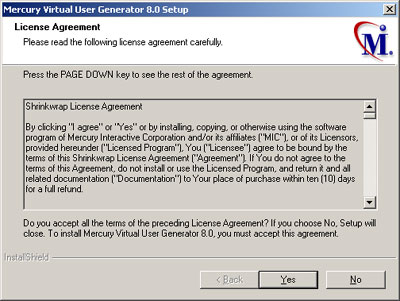People don’t generally read click-through licenses on the software they install. The only license I’ve read with a lawyer-like (or tester-like) attention to detail has been the GPL. The rest have just had a cursory check for any unduly onerous conditions…like the right to spy on my computer or the soul of my first-born child or something equally sneaky.
The LoadRunner license has a couple of surprises in it. I’m not sure how enforceable the license would be, but it’s probably in the best interests of anyone who uses Mercury tools that they are aware of the terms and do their best to comply.

Here are the sections I found interesting…
You may not:
- use the Licensed Program to provide services to any third party, including affiliates or subsidiaries of Licensee, including but not limited to installation, integration, support and testing or monitoring of hardware, software, web sites and/or networking solutions;
Did you ever wonder why Mercury is the only company that will include the use of their products in the price for short-term work? If it wasn’t prohibited by the license, a consultancy company could do a lot of business if they bought a LoadRunner license with a large number of virtual users and took it from company to company. I expect that Rational and Compuware have similar clauses in their licensing agreements, or else you would see consultancy companies doing it with their products instead. I guess that the open source tools are not quite mature enough to do this with yet.
- use, evaluate or view the Licensed Program or Documentation for the purpose of designing, modifying, or otherwise creating any software program, or any portion thereof, which performs functions similar to the functions performed by the Licensed Program;
I heard a story from one of the other load testing tool vendors; they asked for feedback from their users about what features they would like added to the next version of the product. When they combined all the feature requests, they basically had a list of most of the features in LoadRunner.
The license agreement also has a section about reverse engineeing. Mercury, understandably, don’t want anyone making a LoadRunner clone, whether they do it by decompiling the code or just by recreating the features from the documentation or GUI.
- provide externally or to third parties any oral or written communication describing or summarizing the features, functions or performance characteristics of a Licensed Program or Documentation or that compares a Licensed Program to any similar product of Yours or any third party;
This is a bit of a difficult one for anyone who, say, runs a website on performance testing. It means that you can’t really do a comparison of LoadRunner with other tools, even if it is favourable. Fortunately I’m not planning to write a LoadRunner feature list anytime soon.
Definitions, Product Permissions and Restrictions
- A Concurrent License allows for use of a Licensed Program by a specified number of users ordered and paid for by You, over a LAN at the Site, or via browser when the Licensed Program is browser based. A Concurrent License accessed and used by browser may be accessed and used only from the applicable territory or region as ordered and paid for by You, as reflected on MIC’s quote or then-current local published price list, and Your order document ordering a regional or global license as quoted or listed thereon.
I had no idea that Mercury had a regional pricing model, but I guess that makes sense. This just means that companies can’t do what I do on my holidays – bring home cheap products from third-world countries.
- The “LoadRunner” Licensed Program may be used on the Designated Computer to test a website, software program or networking solution located at the Site (“Application under Test” or “AUT”), and execution of the test on the AUT must occur at the Designated Computer. Load generation with Virtual Users (“VUs”) or Virtual User Days (“VUDs”) may take place locally or remotely. LoadRunner may not be accessed or used over a LAN or WAN or via remote access technology, including but not limited to the pcAnywhere product or any products marketed by Citrix Systems, Inc. VUs, VUDs and monitors are licensed to a single Controller and may not be transferred or relocated to a different Controller.
- The “Topaz” Licensed Program may be accessed over a LAN or WAN owned or leased by You or via remote access technology such as pcAnywhere or Citrix products provided the usage ordered and paid for by You is not thereby exceeded.
In other words, don’t use the Terminal Services client (or similar products) with LoadRunner unless you pay for Topaz. I think a lot of people do this anyway, preferring to have their controller box in the server room or data-centre rather than at their desk, and not wanting to sit in a cold noisy room while they do their load test.
8 Comments
Comments are closed.



Yeah, Mercury licensing is despicable. I particularly don’t like the section on creating a software with similar features. All performance testing tools have similat features and performance testing has existed longer than Mercury.
I had once performed a detailed analysis of Loadrunner license. It appeared most restrictive. The most annoying was that I cannot validate LR numbers using any other tool. Also we cannot use any other tool to supplement LR capability or license. It annoying, because Mercury only own the tool. It cannot dictate what else I use for my application.
regards,
Vikram
No-one reads those things anyway. Just look at the one below…
Questions concerning this Agreement should be sent to the address set forth below. By installing this software you accept Jesus Christ as your personal savior, forsaking all other deities in exchange for his everlasting love, forgiveness, and mysterious but tasty wafers. Any notices or correspondences will be effective if sent to such address.
See Something Awful for more…
The remote access clause is just stupid. I’ve worked at least 3 dozen LR engagements with not more than 2 where the controller was not accessed remotely for the reasons you stated. In most cases, I did not have access to the server room where the controller was located. In some cases, I didn’t even know where that room was!
I’d like to see that clause prosecuted.
Hi
Iam gettin one problem during the execution time ..
:”PAGE IS NOT AVAILABLE FOR THIS TIME ”
i.e Dynamic value (JOBNUMBER=2132332)is adding into HTTP Request…
EX: http://182.121.123./DFDD/DFD/JOBNUMBER=2132332
Really i’ll appreciate for you help
Thx
mohan
The license agreement for LR version 9.0 allows for remote access.
according to the HP people I’ve talked to recently, (sales and support) it is ok to use the LR controller in a datacenter via RDP, however those provisions in the EUA are designed to prevent companies from buying a single copy of loadrunner then either
A: providing remote execution capabillity to outsorce contracters in india or elsewhere
B: a multinatiional buying a license for one location and providing RDP or citrix or other access to other business units across the globe.
does Mercury Remote Performance Monitor 8.0 required an additional license?
thnx
I have a question.We have taken a license for 100 users and have used the host ID of one of our systems and got the license Key,My question is can I generate another license key from the smae license that I had purchased for 100 users for a different Host ID/system.